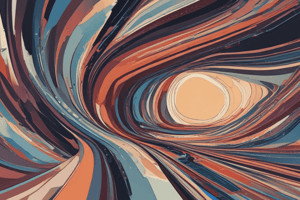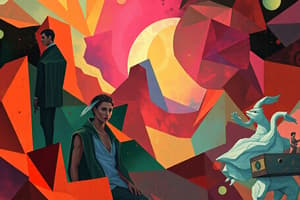Podcast
Questions and Answers
What is a key characteristic of Geometric Abstraction?
What is a key characteristic of Geometric Abstraction?
- Use of large, bold areas of color
- Utilization of simple geometric forms like squares and circles (correct)
- Creation of optical illusions
- Loose, flowing brushstrokes
Which style of art uses color to convey emotions and explore psychological effects?
Which style of art uses color to convey emotions and explore psychological effects?
- Lyrical Abstraction
- Op Art
- Color Field Painting (correct)
- Geometric Abstraction
What common misconception about abstract art is addressed in the text?
What common misconception about abstract art is addressed in the text?
- Abstract art is incomprehensible at first glance (correct)
- Abstract art is always representational
- Abstract art has a single, objective meaning
- Abstract art lacks depth and movement
Which technique is NOT commonly used in abstract art?
Which technique is NOT commonly used in abstract art?
What purpose do varied brushstrokes and textures serve in abstract art?
What purpose do varied brushstrokes and textures serve in abstract art?
Which style of art uses geometric patterns and optical illusions for creating movement and instability?
Which style of art uses geometric patterns and optical illusions for creating movement and instability?
What was a significant contribution of Vincent van Gogh to the emergence of abstract art?
What was a significant contribution of Vincent van Gogh to the emergence of abstract art?
Which movement laid the groundwork for the development of abstract art?
Which movement laid the groundwork for the development of abstract art?
Who published 'Concerning the Spiritual in Art' in 1910, advocating for the use of abstraction to convey emotions?
Who published 'Concerning the Spiritual in Art' in 1910, advocating for the use of abstraction to convey emotions?
What is a defining characteristic of abstract art that sets it apart from traditional art forms?
What is a defining characteristic of abstract art that sets it apart from traditional art forms?
Which movement is recognized as a cornerstone of the Abstract Expressionist movement that emerged in the United States in the 1940s and 50s?
Which movement is recognized as a cornerstone of the Abstract Expressionist movement that emerged in the United States in the 1940s and 50s?
What statement best describes the historical roots of abstract art?
What statement best describes the historical roots of abstract art?
Flashcards are hidden until you start studying
Study Notes
Exploring Abstract Art
Abstract art is a dynamic and intriguing branch of visual art that challenges conventions and defies traditional representation. While it may seem somewhat enigmatic at first glance, its roots are deeply embedded in the artistic traditions of the past. Let's dive into the world of abstract art, exploring its history, techniques, and diverse styles.
Historical Overview
Abstract art emerged in the early 20th century, primarily in Europe, as artists sought to break free from the constraints of realism. The movement began in Post-Impressionism, with Vincent van Gogh's bold, expressive brushstrokes foreshadowing a new era in visual art. Key movements, such as Cubism, Futurism, and Dadaism, laid the groundwork for the development of abstract art.
A pivotal moment occurred in 1910 when Wassily Kandinsky, a Russian artist, published "Concerning the Spiritual in Art," in which he argued that abstraction could convey emotional resonances and spiritual experiences through the use of color, form, and line. Kandinsky's theories became a touchstone for abstract artists, and his work is recognized as a cornerstone of the Abstract Expressionist movement, which emerged in the United States in the 1940s and 50s.
Techniques and Styles
Abstract art defies rigid categorization, as it encompasses a wide variety of styles and techniques. Some common styles include:
- Geometric Abstraction: This style, exemplified by artists such as Piet Mondrian and Kazimir Malevich, uses simple geometric forms, such as squares, circles, and triangles, to create a sense of balance and harmony.
- Color Field Painting: In this style, artists like Mark Rothko and Barnett Newman use large, bold areas of color to convey a sense of depth and emotion.
- Lyrical Abstraction: Artists like Joan Mitchell and Helen Frankenthaler use loose, flowing brushstrokes to create a sense of movement and energy.
- Op Art: This style, which emerged in the 1960s, uses geometric patterns and optical illusions to create a sense of movement and instability.
Techniques used in abstract art include:
- Color: Abstract artists use color to convey emotions, create a sense of depth and movement, and explore the psychological effects of color.
- Line: Artists use linear elements, such as individual strokes or overall compositional lines, to create a sense of movement and energy.
- Form: Abstract artists use various shapes and forms to create a sense of balance, harmony, and contrast within their compositions.
- Texture: Abstract artists use varied brushstrokes, collage, and other techniques to create a sense of depth and tactility in their works.
Challenges and Misconceptions
Abstract art can be a challenging and contentious medium, as it often defies traditional concepts of representation and beauty. Some common misconceptions about abstract art include:
- Lack of meaning: Many people believe that abstract art is devoid of meaning, but in reality, abstract artists use a variety of techniques and styles to convey complex emotional and philosophical ideas.
- Incomprehensibility: Abstract art can appear confusing or obtuse at first glance, but with time and careful consideration, it becomes clear that abstract works often contain a wealth of meaning and insight.
- Subjectivity: Because abstract art defies traditional representational techniques, some people believe that its meaning is entirely subjective. However, abstract artists often use specific techniques and styles to convey specific emotional and philosophical ideas.
Conclusion
Abstract art is a fascinating and enigmatic medium that challenges traditional concepts of representation and beauty. By exploring its history, techniques, and styles, we can appreciate the intricate and thoughtful works created by abstract artists. So, next time you encounter an abstract painting, don't be afraid to dive in and explore its mysteries. You might just discover a new and exciting world of art that speaks to your own unique experiences and perspectives.
Studying That Suits You
Use AI to generate personalized quizzes and flashcards to suit your learning preferences.




